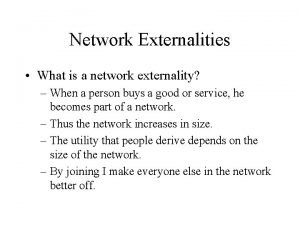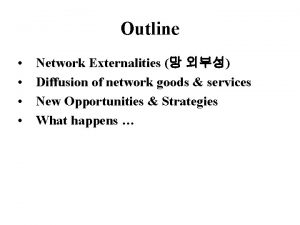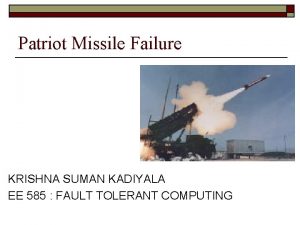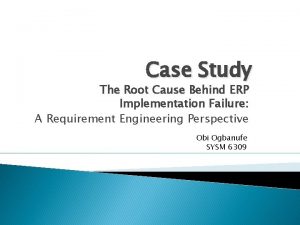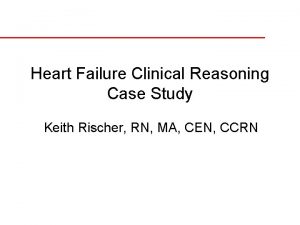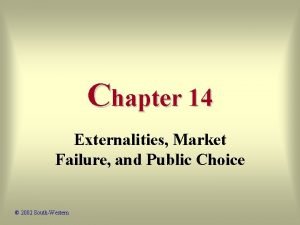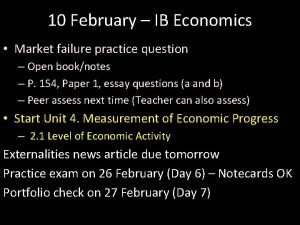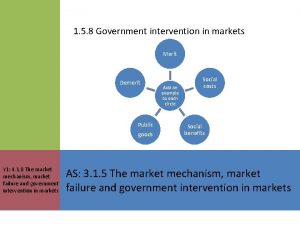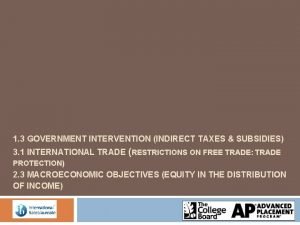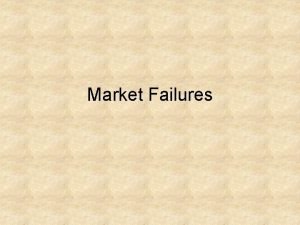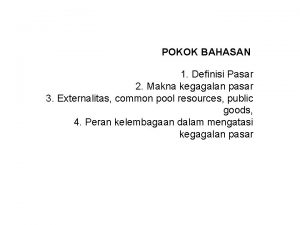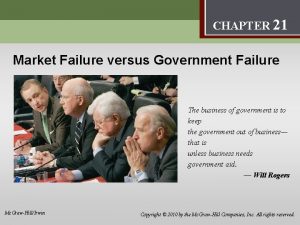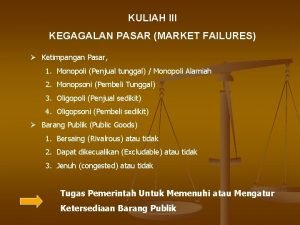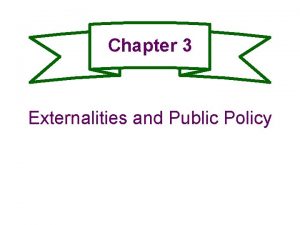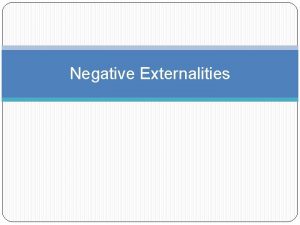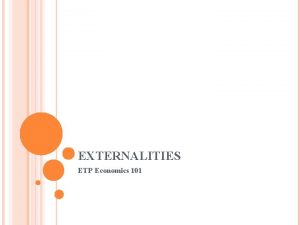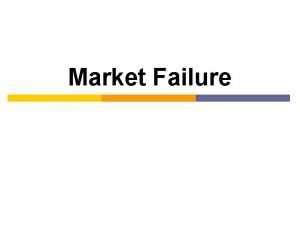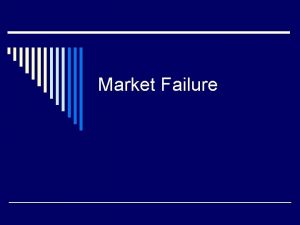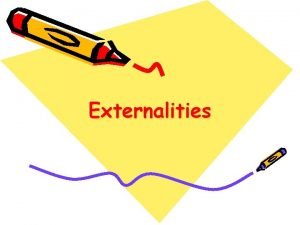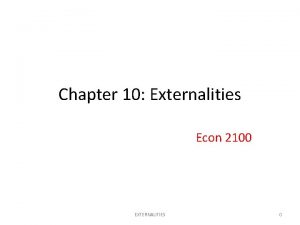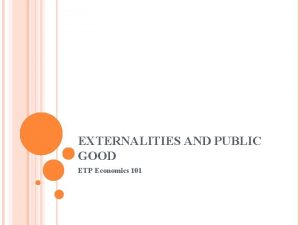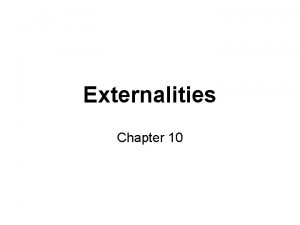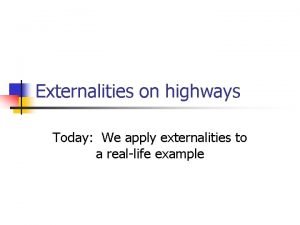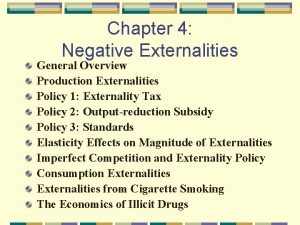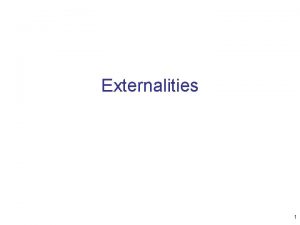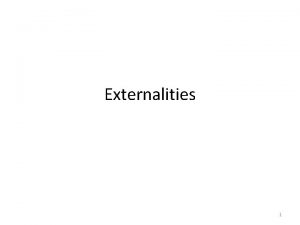Market Failure The Case of Externalities Market Failure









































- Slides: 41

Market Failure The Case of Externalities Market Failure = the inability of a system of private markets to provide certain goods or services, either at all, or at the most desirable or ‘optimal’ levels. Externality = where there are effects, either good or bad, of an economic action (usually production or consumption), on parties not directly involved in that action. Government may act to force the party causing the externality to account for the external effects in their decision making process, i. e. , to internalize the externality.

At one time, there were no neighbors to be affected by one’s decisions. (Homestead remains from the early 1900’s in the Lost River Valley above Arco, ID)

In modern society, almost any consumption or production affects somebody. Source: USDA, NRCS http: //photogallery. nrcs. usda. gov

How to offset or mitigate your property value damages caused by bad neighbors? Source: USDA, NRCS http: //photogallery. nrcs. usda. gov

Neighbors help each other with landscaping projects – it increases their property values and satisfaction. Source: USDA, NRCS http: //photogallery. nrcs. usda. gov

Private Marginal Benefit - MPB The price that represents what a consumer is willing to pay for another unit of a good is referred to as the PMB, using a standard market demand supply graph. Price D = MPB = Demand Quantity

Private Marginal Cost - MPC The price at which a producer is willing to bring another unit of a good to the market is referred to as the MPC, using a standard market Demand Supply graph. Price S = MPC = Supply Quantity

Marginal External Costs - MEC Production may impose Marginal External Costs on other producers. These may be negative, increasing the costs of the 3 rd party, or positive, reducing the costs of the 3 rd party. Price S = PMC MEC for Negative Externality Quantity MEC for Positive Externality

Marginal External Benefits - MEB Consumption may impose Marginal External Benefits on other consumers. These may be positive, increasing the benefits of the 3 rd party, or negative, reducing the benefits of the 3 rd party. Price D = PMB MEB for Positive Externality MEB, Negative Externality Quantity

Competitive Outcome Occurs at the quantity where the demand supply curves intersect, where MPB = MPC. This is the best alternative private use of the resources. Price D = MPB S = MPC P* Q* Quantity

Optimal Social Outcome Marginal Social Benefit (MSB) = Marginal Social Cost (MSC), the best alternative Social use of the resources. D = MPB = MSB Price MSC = MPC + MEC S = MPC MSB = MSC P 1 P* MEC for Negative Externality Q 1 Q* Quantity

Neighbor’s Decision on Patio Stereo System Size Negative Externality, Consumer Affect on a Consumer

Internalizing Your Damage in Neighbor’s Stereo Purchase Decision Competitive Outcome Optimal Social Outcome Q

Neighbor’s Dog Production Decreases Your Enjoyment Negative Externality, Producer on Consumer

Competitive vs Optimal Social Level of Dog Production Optimal Social Outcome Competitive Outcome Q

How Much Should Rancher Spend on Brush Control and Trail Maintenance? Positive Externality, Producer on Producer

Production results in positive externality to 3 rd party producer Optimal Social Outcome Competitive Outcome

Coase Theorem Externalities do not give rise to misallocation of resources if transactions costs are small and property rights are defined and enforceable. The Parties involved would have a market incentive to negotiate a mutually beneficial trade to internalize the externality. The neutrality theorem says that the physical outcome, but not the distribution of welfare, does not depend on which party holds the property rights.

Coase Theorem Result Whether or not the 3 rd party or the producer has the property right, the consumer pays P 1 and Q 1 is produced Price P 1 P* P 2 Damages at Q 1 = Min. Potential compensation to 3 rd party where 3 rd party has Property right. D = MPB MSC = MPC +MEC S = MPC b a a + b = Max. potential bribe from 3 rd party to producer where producer has property right. MEC Q 1 Q* Quantity

Government Tools to Address Externalities • Impose a tax equal to the MEC for negative externalities • Give a subsidy equal to the MEB for positive externalities • Impose a regulation limiting Q to the Optimal Social Level • Establish property rights so that affected parties can seek compensation • Establish markets for trading of pollutant rights • Establish an educational program • Support Research and Development activity to alter production technology or mitigate externalities

Single Firm (Price Taker) Producer Welfare Loss for Output Tax vs Regulation vs Externality Tax P MSC = MPC + MEC Output Tax Regulation MPC Market Price Tax Externality Tax Q 2 MEC Q 1 Q

Pollutant Trading Reduces Compliance Cost C outbids B and purchases 90 permits from A and then 10 from B. Final market price would be about $5. For permits that A would be Willing to sell, C would outbid B, but wouldn’t need to go above $5. Total Net compliance cost is now reduced to $550: A: $4 * (10 + 90) – ($5*90) = -$50 B: $5 * (20 + 10) – ($5*10) = $100 C: $5 * 100 = $500

Government Intervention is Costly A. Internal costs to the government for salaries, supplies, etc. 1. Deadweight loss of 25 cents per dollar of tax collected 2. Administrative costs of as high as 25 percent for program administration and oversight B. Costs imposed on those regulated – direct external costs. 1. Change in cost of production (inputs and technology) 2. Costs of compliance such as red tape reporting 3. Losses in productivity due to decreased incentives for growth C. Indirect 3 rd party costs, sort of like externalities 1. Such as a 3 year delay to bring a new drug on the market

Government Intervention May Be Imperfect 1. Imperfect knowledge or foresight. 2. Rigidities, both technically and institutionally. 3. Inefficient tools. A strict rule may be so difficult to enforce, that it does less good than a milder one with higher compliance. 4. Myopic regulation; not seeing the big picture. 5. Political constraints. 6. Decision maker’s objectives.

Government Wide Priority Setting? There are many “needs” that never get “sponsored” by a congressman. Demand for a government wide comparison of B: C ratios across all programs is apparently very weak. So what if all the natural environment programs have benefits greatly exceeding cost? Perhaps the funds would yield even greater benefits if spent on housing, education, roads, etc.

Environmental Quality Incentives Program (EQIP) • A voluntary conservation program that promotes productive use of private land environmental quality as compatible National Goals. • Landowners may receive financial and technical help to install structures on their land or change their technology use and management choices in ways that benefit the environment. • Federal assistance may be combined with assistance from state and local government, and non-profit groups.

EQIP Internalizes Externalities - Assists some landowners comply with regulations that were originally imposed to correct environmental externalities - For non-regulated landowners who choose to participate, subsidies and educational assistance are given so that both beneficial and harmful effects to the environment are voluntarily internalized

Government employee assists private landowners to plan and install environmental practices for EQIP. Source: USDA, NRCS http: //photogallery. nrcs. usda. gov

Farm ponds provide many benefits including livestock water, gully control, fish and wildlife habitat. Source: USDA, NRCS http: //photogallery. nrcs. usda. gov

Establishment of windbreak to protect highway from drifting snow and soil. Source: USDA, NRCS http: //photogallery. nrcs. usda. gov

Rockwork protecting bank from erosion and buffer strip to intercept pollutant runoff. Source: USDA, NRCS http: //photogallery. nrcs. usda. gov

Forest stand improvement by thinning and removal of under story brush benefits landowner and wildlife. Source: USDA, NRCS http: //photogallery. nrcs. usda. gov

Establishment of wildlife habitat in critical areas. Source: USDA, NRCS http: //photogallery. nrcs. usda. gov

Ranchers in Salmon River valley install improved irrigation water diversion structures that also benefit salmon migration. Source: USDA, NRCS http: //photogallery. nrcs. usda. gov

Lined irrigation ditch and individual siphon tubes reduce water losses, reducing costs, making more water available for society. Source: USDA, NRCS http: //photogallery. nrcs. usda. gov

With 10’s of thousands of cows, manure production exceeds assimilation capacity of nearby available land.

Buffer strips, terraces, windbreaks, and other practices in a complete conservation system protect the land improve the water quality in Prairie Rose Lake in Shelby County, Iowa. Source: USDA, NRCS http: //photogallery. nrcs. usda. gov

Subsidy to induce technology switch, maintain output Social Outcome improved, but not optimized P Subsidy set at (P 2 – P 1) to maintain production at Q 1 S 2=MPC 2 S 1=MPC 1 P 2 P 1 D=MPB Q 1 Q MEC 1 MEC 2

Summary - 1 An externality is where effects of a consumption or production decision affect a 3 rd party, whose interests are not considered in the decision. The presence of externalities may indicate market failure if they are not internalized in the decision making – market failure because the private competitive outcome is not the best social use of resources. If a negative externality, generally too much is produced or consumed. If a positive externality, generally too little is produced or consumed. Presences of large transactions costs and lack of defined and enforceable property rights inhibit private externality internalization. And, society may not like the equity or welfare distribution implications of that private internalization.

Summary - 2 The government may force externality internalization with: Taxes Subsidies Regulation Establishment of property rights Markets for the externality Education and technical assistance Research and Development for new technology Government action may be less than optimal, fail, or even make things worse due to information, enforcement, vision, and political constraints. Critics have long referred to economics as the “Dismal Science”. There are “pros and cons” and “tradeoffs” to every decision.

Conclusion Economics is fun. Economics is truly the science of life. Understanding of economic principles can greatly improve ones ability to deal with the complexities of modern society. • Personal economic choices • Resolving conflicts in an equitable manner.
 What is a network externality
What is a network externality Externalities in environmental economics
Externalities in environmental economics Externalities and public goods microeconomics
Externalities and public goods microeconomics Externalities problems and solutions
Externalities problems and solutions Deadweight loss in positive externality
Deadweight loss in positive externality Myspace
Myspace Example of negative externality
Example of negative externality Ventricular escape rhythm
Ventricular escape rhythm Failure to pace vs failure to capture
Failure to pace vs failure to capture Ductile fracture vs brittle fracture
Ductile fracture vs brittle fracture Best case worst case average case
Best case worst case average case Crm failure case study
Crm failure case study Patriot missile
Patriot missile Erp implementation failure a case study
Erp implementation failure a case study Nasa system failure case studies
Nasa system failure case studies Keith rn heart failure case study
Keith rn heart failure case study Leader challenger follower
Leader challenger follower Segmenting targeting and positioning
Segmenting targeting and positioning Define market failures
Define market failures Role of government in correcting market failure
Role of government in correcting market failure Dineshbakshi economics
Dineshbakshi economics Indirect tax to correct market failure
Indirect tax to correct market failure Hardship transfer examples
Hardship transfer examples Market failure quiz
Market failure quiz Market failures
Market failures Types of market failure
Types of market failure Pengertian market failure
Pengertian market failure Market failure examples
Market failure examples Kegagalan pasar
Kegagalan pasar Hình ảnh bộ gõ cơ thể búng tay
Hình ảnh bộ gõ cơ thể búng tay Frameset trong html5
Frameset trong html5 Bổ thể
Bổ thể Tỉ lệ cơ thể trẻ em
Tỉ lệ cơ thể trẻ em Gấu đi như thế nào
Gấu đi như thế nào Chụp phim tư thế worms-breton
Chụp phim tư thế worms-breton Chúa sống lại
Chúa sống lại Môn thể thao bắt đầu bằng từ chạy
Môn thể thao bắt đầu bằng từ chạy Thế nào là hệ số cao nhất
Thế nào là hệ số cao nhất Các châu lục và đại dương trên thế giới
Các châu lục và đại dương trên thế giới Công của trọng lực
Công của trọng lực Trời xanh đây là của chúng ta thể thơ
Trời xanh đây là của chúng ta thể thơ Mật thư tọa độ 5x5
Mật thư tọa độ 5x5
